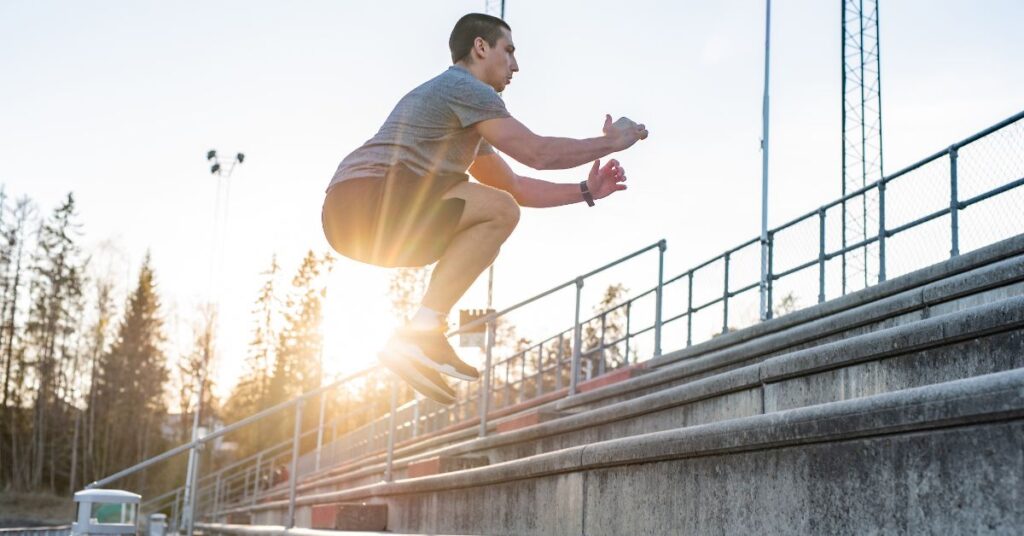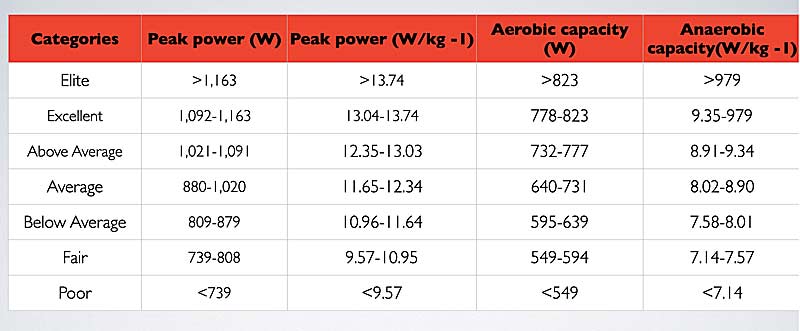
Fair warning: improving an athlete’s anaerobic lactic abilities is not for the faint of heart. The work is intense and, if done correctly, can push an athlete to their limits. With that said, an efficient and powerful anaerobic lactic system can play a significant role in how much success athletes have during competition. Nothing good comes easy, right?
This article will take a look at the anaerobic lactic (glycolytic) energy system. Details will be given on when the glycolytic system is relied upon, how the system creates energy, and various methods to improve the system for different levels of athletes (beginner, intermediate, and advanced).
Anaerobic means “without oxygen,” and lactic means there will be a buildup of the wrongly vilified byproduct of anaerobic (and aerobic) exercise, lactic acid. The glycolytic system does not require oxygen to produce adenosine triphosphate (ATP), which is the fuel your muscles run on, and lactic acid will accumulate within the muscles being used.
As mentioned in our previous article on aerobic fitness, the aerobic energy system can produce ATP for extremely long durations but cannot produce energy at a fast rate for explosive movements. This is where the anaerobic systems (both the glycolytic system and the anaerobic alactic system, the topic of a different article) come into play. The glycolytic system can provide ATP for 60–90 seconds before fatigue sets in. To use a car analogy, if the aerobic system is an athlete’s gas tank, the glycolytic system can be thought of as a car’s ability to operate at its highest RPM for just over 60 seconds. Imagine putting the gas pedal to the floor and going as fast as the car is capable of for one minute.
Most people have been led to believe two myths about lactic acid: It causes the burning sensation felt during a workout and is responsible for muscle soreness the day after a workout. Share on XWhen discussing the glycolytic system, it’s important to discuss the role of lactic acid. The anaerobic system’s main substrates are glucose (blood sugar) and glycogen (stored sugar). We will use the general term “carbohydrate” for both glucose and glycogen in the rest of this article. During the process of breaking these substrates down to produce ATP, lactic acid is created and accumulates in the working muscles. Most people have been led to believe two myths about lactic acid:
- Lactic acid causes the burning sensation felt in the working muscles during a workout.
- Lactic acid is responsible for muscle soreness the day after a workout.
These are both false. The buildup of hydrogen causes the burning sensation felt during exercise, and the tearing of muscles during exercise causes muscle soreness in the days after a workout.
Lactic acid actually assists in prolonging exercise duration, as it can be converted to glucose—which can then be used to produce more ATP. There are multiple steps in the process of converting lactate to ATP that are outside the scope of this article, but with the help of mitochondria and the Krebs cycle, lactate oxidation takes place and ultimately leads to lactate being an important substrate that affects how long an athlete can perform for.
Measuring and tracking glycolytic endurance may not be as important as measuring and tracking aerobic fitness unless the athletes being trained are short- to mid-distance track runners. In that case, comparing sprint times and comparing splits are easy ways to see what progress is being made.
If coaches or athletes want to measure glycolytic endurance, the 30-second Wingate test is easy to perform and doesn’t take long to complete. An explanation of the test can be found here. Zupan et al. (2009) conducted a study to create classification guidelines for the 30-second Wingate test for both male and female collegiate athletes. Their results can be found below.


Author’s note: Throughout these articles on conditioning, the main citation used will refer to Joel Jamieson’s Ultimate MMA Conditioning. While this book is specific to mixed martial arts, the methods discussed in it can be applied to any sport, from cross country to shot put. During my years as an athletic performance student, my mentors referred to Ultimate MMA Conditioning as the gold standard for energy system development (ESD). As I have ventured into running a year-round high school athletic performance program for various sports, I have found Jamieson’s methods to be second to none.
Jamieson defines conditioning as “a measure of how well an athlete is able to meet the energy production demands of their sport.” This means that a basketball player who can jump, cut, and shoot efficiently while still making it back on defense for the entirety of the game is just as conditioned as a long jumper who can jump and recover three or more times during a meet. Simply put, conditioning is specific to the sport at hand.
How Do You Improve Glycolytic Fitness?
There are two components of glycolytic fitness that affect how efficient the system is: glycolytic power and glycolytic capacity. There are two contributing factors to glycolytic power. The first is how “glycolytic” your muscle tissues are. Glycolytic muscle tissues rely heavily on the anaerobic system for ATP and contain a high number of the enzymes that are necessary to break down glucose for energy.
Another contributing factor to glycolytic power is the development of the nervous system. The more developed an athlete’s nervous system is, the more efficient their body will be at activating and coordinating the muscles needed to produce high levels of power.
How do you go about developing an athlete’s nervous system? Spend more time lifting relatively heavy weights in the weight room.
Glycolytic capacity mainly depends on how well an athlete can tolerate the byproducts of anaerobic exercise. Included in this is how efficient the body is at converting lactic acid to glucose and, ultimately, back to ATP. As mentioned previously, the buildup of hydrogen during intense exercise is believed to be the cause of the burning sensation in the working muscles. The presence of hydrogen decreases the acidity of the muscle cells, and the ability to clear this hydrogen from the working muscles helps improve glycolytic capacity. Another factor in glycolytic capacity is the availability of the proper substrates, mainly glucose and glycogen.
There are fewer ‘moving parts’ in the glycolytic system than in the aerobic system. This means the ability to improve this system through training is limited, says Alex Roberts & @Steve20Haggerty. Share on XIt should be noted that there are fewer “moving parts” in the glycolytic system than in the aerobic system. This means the ability to improve this system through training is limited. Research has shown that the glycolytic system is also limited by genetics (Bouchard et al., 1992). You should keep these two points in mind when training to improve an athlete’s glycolytic system.
To summarize, there are two ways to improve this system:
- Glycolytic power is improved by producing as much energy as possible in the appropriate amount of time (15–90 seconds).
- Glycolytic capacity is improved by sustaining this high level of output for a longer period.
Beginner
The beginner athlete has rarely, if ever, done true conditioning work. It’s even rarer for them to have done conditioning specific to their glycolytic system. Before implementing any specific conditioning parameters with these athletes, your initial focus should be on having them understand what working at maximal intensity for 15–30 seconds feels like. An easy way to do this is by having athletes perform 15-second reps of a full-body, high-intensity movement (sprints, assault bike sprints, sport-specific movements, etc.). One set of three reps, with 90 seconds of rest between reps, should do the job. Ensuring they know what 100% intensity feels like will help prevent wasted conditioning sessions.
Once athletes have a feel for where they should be working during glycolytic training sessions, you can implement glycolytic power intervals. Glycolytic power intervals improve glycolytic fitness by:
- Forcing the working muscles to rely more on anaerobic metabolism.
- Increasing the presence of enzymes involved in breaking down glucose within the working muscles.
With any type of power training, any effort less than maximum will be insufficient. Furthermore, strict rest periods are essential to ensure the desired training stimulus is being targeted. A wide variety of exercises can be used as long as they are explosive (preferably full-body) movements. Sprinting, lunge jumps, squat jumps, etc., are all great choices. Exercises specific to the athlete’s sport can also be prescribed. Keep in mind that only the working muscles will reap the adaptations mentioned above.
During glycolytic power intervals, reps should last 20–40 seconds (starting on the lower end). Athletes should be given 1–3 minutes of rest between each rep, depending on how long their working reps last. Perform three reps per set and 2–4 sets per session. They should be given 8–15 minutes of rest between sets. Active rest is ideal, but beginner athletes can start with true rest for the first 1–2 months.
To reiterate, the rest intervals—both during and between sets—are extremely important to ensure the proper stimulus is being provided for beginner athletes, says Alex Roberts & @Steve20Haggerty. Share on XOne session per week should be sufficient for beginner athletes. To reiterate, the rest intervals—both during and between sets—are extremely important to ensure the proper stimulus is being provided. The beginner athlete won’t be able to fully recover between reps but should be able to fully recover between sets.

Intermediate
An athlete who has performed at least three months—or one full off-season—of consistent glycolytic power intervals can be bumped up to the intermediate level. With a solid foundation of glycolytic power abilities, the focus can be shifted to maintaining maximal glycolytic outputs for longer periods.
Glycolytic capacity intervals are the next step in improving the ability of the glycolytic system. The shift from power intervals to capacity intervals simply has to do with work-to-rest ratios. Capacity intervals call for longer work intervals and shorter rest periods. These intervals improve the glycolytic system by increasing the body’s ability to buffer the byproducts of anaerobic exercise, leading to longer maximal outputs.
Apart from the differing work:rest ratios, glycolytic power and capacity intervals are very similar. The same exercises can be used. In fact, if not the same, it’s recommended to at least keep the exercises similar. This helps keep the transition from power to capacity work as smooth as possible.
During glycolytic capacity intervals, reps should last 90–120 seconds, and rest intervals should be decreased to 1–2 minutes. Three reps per set and 2–4 sets per session remain identical to the power intervals. Active rest (jogging, jump rope, stationary bike, etc.) between sets should last 4–6 minutes.
It’s important to remind athletes to complete all reps at the highest intensity possible, even if they feel fatigue setting in halfway through the reps, says Alex Roberts & @Steve20Haggerty. Share on XWith shorter rest and longer work intervals, this method will be much more intense than the power intervals. It’s important to remind athletes to complete all reps at the highest intensity possible, even if they feel fatigue setting in halfway through the rep. Being able to perform at high intensities for long periods can directly affect an athlete’s success.

Advanced
After athletes have completed at least three months or one full off-season of glycolytic capacity intervals, they can begin working on advanced methods. They should have a solid foundation of glycolytic power and capacity. Staying consistent with the methods described in the previously published aerobic system article, advanced athletes will transition to explosive repeats specific to the glycolytic system.
Glycolytic explosive repeats can be thought of as intensified glycolytic capacity intervals, meaning even shorter work:rest ratios. This method increases the presence of enzymes involved in glycolytic ATP production and continues to improve the body’s ability to buffer byproducts of anaerobic exercise.
The glycolytic explosive repeat method calls for increased work and decreased rest every week. Work intervals can be anywhere from 12–40 seconds, while rest intervals should be between 10 and 30 seconds. Choose 1–3 exercises (ideally similar/identical to the previously used exercises), perform 6–10 sets per exercise, and complete this up to three times in a session. Six to eight minutes of active rest should be completed between each series.
As athletes get further into the program, work and rest times should be inversely related... The explosive repeat method is simple and easy to progress, says Alex Roberts & @Steve20Haggerty. Share on XAs athletes get further into the program, work and rest times should be inversely related. This means work intervals will start low (12 seconds) during week 1 and increase to 40 seconds by the time week 4 comes around. Rest intervals will start high (30 seconds) and decrease to 10 seconds during week 4. Example:
- Week 1: 12–15 seconds of work, 30 seconds of rest.
- Week 2: 15–20 seconds of work, 20 seconds of rest.
- Week 3: 20–30 seconds of work, 15 seconds of rest.
- Week 4: 30–40 seconds of work, 10 seconds of rest.
The explosive repeat method is simple and easy to progress. By the time athletes reach the advanced level, they should be well-prepared to handle weekly intensifications. To make your program’s glycolytic explosive repeat portion last longer than four weeks, increase the work interval by 2–3 seconds and decrease the rest interval by 2–5 seconds each week.
An athlete’s ability to generate extremely high amounts of power during short, explosive bouts of exercise can be the difference between winning and losing. First, getting athletes to understand what it feels like to work at or near maximal exertion and then progressively having them maintain that output for a longer period will get their bodies better at producing and maintaining high energy outputs.
Athletes who can maintain power outputs throughout the full length of the competition—whether that’s the wrestler whose tenth shot looks and feels identical to their first shot, the running back who breaks a 70-yard touchdown run in the last minute of the game, or the 400-meter sprinter who can put it into sixth gear on the final straight of the race—are usually the ones that come out on top. Increase an athlete’s glycolytic ability and watch them pull away from the opponent during the final moments of competition.
References
Bouchard C, Dionne FT, Simoneau, JA, and Boulay MR. “Genetics of aerobic and anaerobic performances.” Exercise and Sport Sciences Reviews. 1992;20:27–58.
Cairns SP. “Lactate oxidation in human skeletal muscle mitochondria.” American Journal of Physiology-Endocrinology and Metabolism. 2013;304(7):E686–E694.
Jamieson, J. (2009). Ultimate MMA Conditioning. Performance Sports Inc.
Zupan MF, Arata AW, Dawson LH, Wile AL, Payn TL, and Hannon ME. “Wingate Anaerobic Test Peak Power and Anaerobic Capacity Classifications for Men and Women Intercollegiate Athletes.” Journal of Strength and Conditioning Research. 2009;23(9):2598–2604.
Since you’re here…
…we have a small favor to ask. More people are reading SimpliFaster than ever, and each week we bring you compelling content from coaches, sport scientists, and physiotherapists who are devoted to building better athletes. Please take a moment to share the articles on social media, engage the authors with questions and comments below, and link to articles when appropriate if you have a blog or participate on forums of related topics. — SF
 Steve Haggerty is a sports performance coach at Parkview Sports Medicine (PSM) in Fort Wayne, Indiana, and an NFL Draft Prep specialist at Bommarito Performance Systems (BPS) in Miami, Florida. He spent the last two years at BPS working with NFL Pro Bowlers as well as MLB and NHL All Stars in their off-season training. Haggerty took on the lead role of preparing college football players for the NFL Combine and Pro days. At PSM, he leads the youth “Edge” program with athletes from a variety of different ages and sports.
Steve Haggerty is a sports performance coach at Parkview Sports Medicine (PSM) in Fort Wayne, Indiana, and an NFL Draft Prep specialist at Bommarito Performance Systems (BPS) in Miami, Florida. He spent the last two years at BPS working with NFL Pro Bowlers as well as MLB and NHL All Stars in their off-season training. Haggerty took on the lead role of preparing college football players for the NFL Combine and Pro days. At PSM, he leads the youth “Edge” program with athletes from a variety of different ages and sports.

Sorry, so for beginner sprinters I should have them sprint full speed for 15 secs. and then a 90 second recovery before the do the next rep!? Thanks